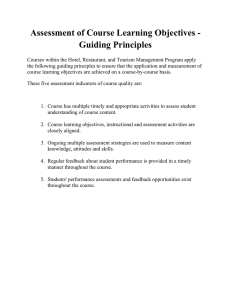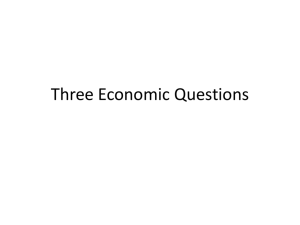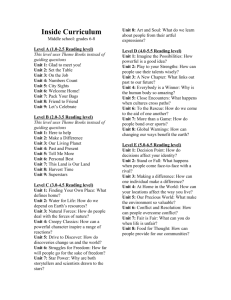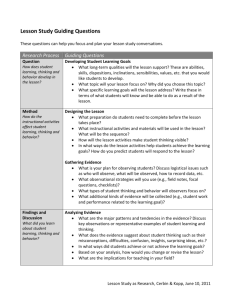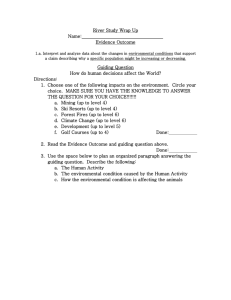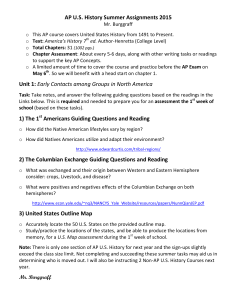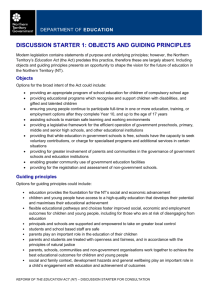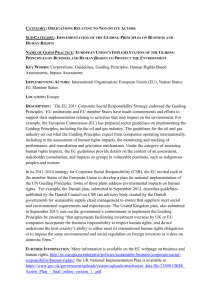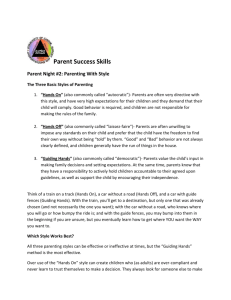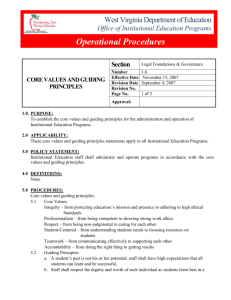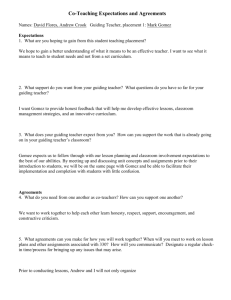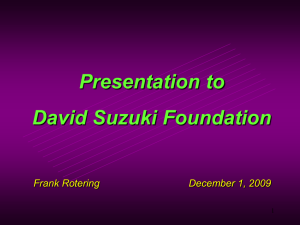Organizational Planning
advertisement
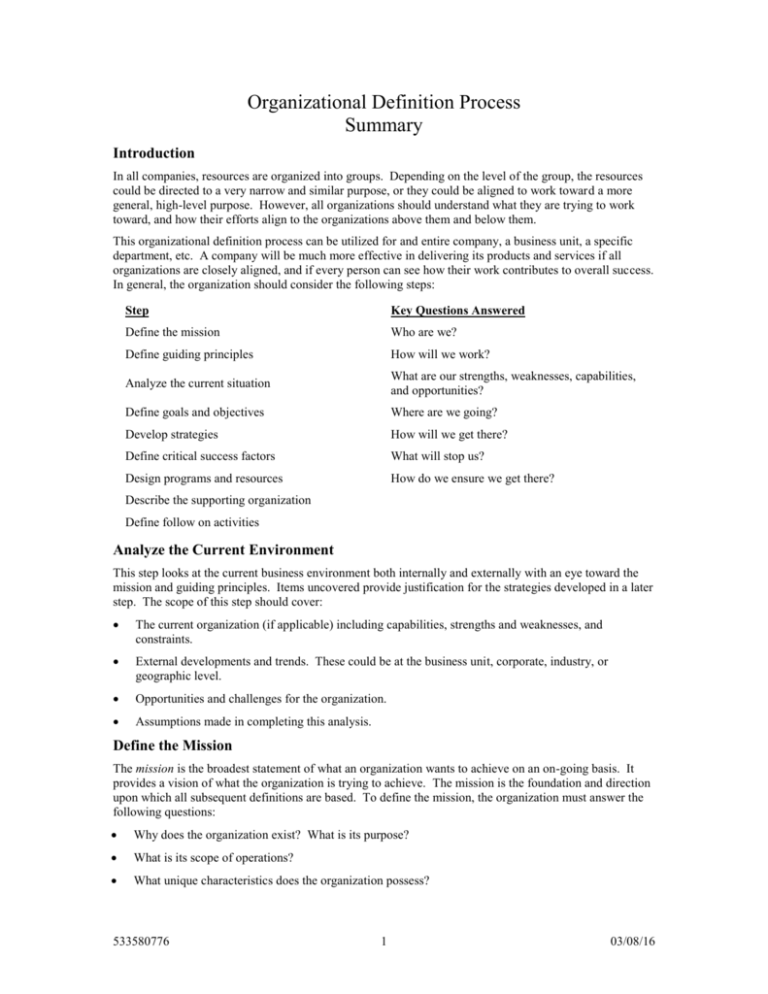
Organizational Definition Process Summary Introduction In all companies, resources are organized into groups. Depending on the level of the group, the resources could be directed to a very narrow and similar purpose, or they could be aligned to work toward a more general, high-level purpose. However, all organizations should understand what they are trying to work toward, and how their efforts align to the organizations above them and below them. This organizational definition process can be utilized for and entire company, a business unit, a specific department, etc. A company will be much more effective in delivering its products and services if all organizations are closely aligned, and if every person can see how their work contributes to overall success. In general, the organization should consider the following steps: Step Key Questions Answered Define the mission Who are we? Define guiding principles How will we work? Analyze the current situation What are our strengths, weaknesses, capabilities, and opportunities? Define goals and objectives Where are we going? Develop strategies How will we get there? Define critical success factors What will stop us? Design programs and resources How do we ensure we get there? Describe the supporting organization Define follow on activities Analyze the Current Environment This step looks at the current business environment both internally and externally with an eye toward the mission and guiding principles. Items uncovered provide justification for the strategies developed in a later step. The scope of this step should cover: The current organization (if applicable) including capabilities, strengths and weaknesses, and constraints. External developments and trends. These could be at the business unit, corporate, industry, or geographic level. Opportunities and challenges for the organization. Assumptions made in completing this analysis. Define the Mission The mission is the broadest statement of what an organization wants to achieve on an on-going basis. It provides a vision of what the organization is trying to achieve. The mission is the foundation and direction upon which all subsequent definitions are based. To define the mission, the organization must answer the following questions: Why does the organization exist? What is its purpose? What is its scope of operations? What unique characteristics does the organization possess? 533580776 1 03/08/16 Who are the organization’s clients or customers? Define Guiding Principles Guiding principles are basic and high-level understandings that determine the ways that decisions are made and activities are conducted. They answer the question, “How will we work together and with others?” Principles support the Mission Statement. Examples include creating a team learning environment, continuous process improvement, commitment to excellence, staff empowerment, etc. Define Clients/Customers and Stakeholders Clients are the individuals or groups that engage your organization to provide products and services that address their business needs. In some organizations, clients and customers refer to the same people. In others a client may be defined as others within the same company, while a customer is outside. Stakeholders are individuals or groups who have a stake in the outcome of the project or activity, but are not clients or customers. Understanding the major clients/customers allows the organization to focus on meeting the expectations of the right parties. Define Goals and Objectives A goal describes a high-level target state that an organization desires to achieve over the long-term (three to five years). Objectives are more specific statements that describe what the organization wants to accomplish in the short-term (twelve months or less). The successful completion of short-term objectives should contribute to the achievement of long-term goals. Develop Strategies A strategy is an overall course of action for deploying and utilizing resources to achieve a goal. Strategies are derived based upon the organization’s mission, guiding principles, goals and objectives. Potential strategies are evaluated during the business planning processes to ensure they address the critical success factors and that they will add value. Successful strategies typically have the following key features: They are directed toward unambiguous goals, provide direction, and may be assigned to departments or groups rather than to people. Each strategy should support at least one goal and each goal should have at least one strategy supporting it. They are based upon an insight about the internal and external environment. They should concisely state what will be done to attain each goal. They are based upon organization’s self-knowledge of its capabilities. For each potential strategy, evaluate resource demands and requirements against the resources available. They are implemented with resolution and coordination that effectively harnesses the capability and commitment of the organization charged with fulfilling the strategy. To achieve this, assess the capability of the organization to embrace, execute, and fulfill the strategy. Each strategy should indicate some level of priority and indication of criticality. Define Critical Success Factors Critical success factors (CSFs) are internal, measurable, business-related practices that will have, on an ongoing basis, a major influence on whether or not the organization meets its goals. CSFs are the "things that must go right” and may be processes, behaviors, attitudes, activities, or desired end states. Critical success factors for each strategy should be clearly defined. 533580776 2 03/08/16 Define Products and Services Products are the deliverables that the organization produces and supports. Products are created to help achieve the organization’s goals and objectives. Services define work that is performed for a client or customer. Design Programs and Projects Projects are a way to organize work necessary to achieve, or contribute to the achievement of, an objective. A program is a group of related projects that address a common objective, or set of objectives. A high level description of the projects and programs should include definitions and high-level resource requirements. Describe the Organization’s Roles, Responsibilities and Skills Roles are functional positions with a specific set of responsibilities to perform the work required to achieve the goals and objectives. The output of this step could be an organizational chart with narrative descriptions of each role, a responsibility matrix showing the type of responsibility (e.g., responsible, authorizes, supports, involved or informed), and the set of skills each role must have to be successful. Define Follow-on Activities This step makes the organization definition a reality. Potential activities may include presentations, completing more detail for the plan components, and/or continuing meetings and discussions. This step helps provide assurance that the plan will be implemented. 533580776 3 03/08/16
